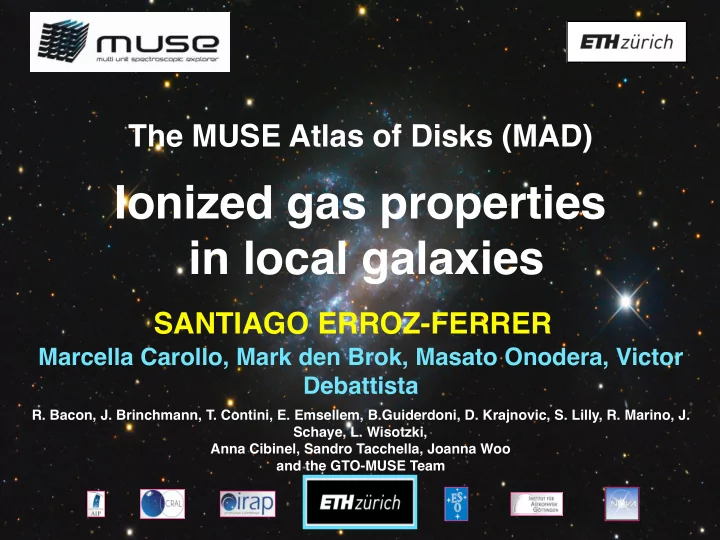

The MUSE Atlas of Disks (MAD) Ionized gas properties in local galaxies SANTIAGO ERROZ-FERRER Marcella Carollo, Mark den Brok, Masato Onodera, Victor Debattista R. Bacon, J. Brinchmann, T. Contini, E. Emsellem, B.Guiderdoni, D. Krajnovic, S. Lilly, R. Marino, J. Schaye, L. Wisotzki, Anna Cibinel, Sandro Tacchella, Joanna Woo and the GTO-MUSE Team
Ionized gas properties at <100 pc scales 2D maps of gas diagnostics derived from strong emission lines Number of Voronoi cells Median = 26 pc ~500000 cells Erroz-Ferrer et al. (in prep) Malta 2017 Santiago Erroz-Ferrer serrozfe@phys.ethz.ch
BPT parameter AGN/. shock P 2 η P 1 P 3 SF η<#0.5 #0.5<η<0.5 η>0.5 New BPT parameter: η Malta 2017 Santiago Erroz-Ferrer serrozfe@phys.ethz.ch
Ionized gas properties at <100 pc scales 2D maps of gas diagnostics derived from strong emission lines Malta 2017 Santiago Erroz-Ferrer serrozfe@phys.ethz.ch
Gas metallicity inside 0.5 Re Calibrations with different nature: 1. Empirical calibrations using HII regions, e.g., Marino et al. 2013 (M13) 2. Photoionzation models, e.g., Dopita et al. 2016 (DOP16) • We adopt the calibration in Dopita et al. 2016 as fiducial (can be used for regions with hard radiation fields) ➡ MASS-METALLICITY RELATION AT 0.5 Re FOR ALL STRUCTURES! ➡ EMPIRICAL CALIBRATIONS SATURATE Malta 2017 Santiago Erroz-Ferrer serrozfe@phys.ethz.ch
Gas metallicity gradients Malta 2017 Santiago Erroz-Ferrer serrozfe@phys.ethz.ch
Gas metallicity gradients: summary Gradients ALL SF gas HII ➡ Using Dopita calibration eliminates rising gradients ➡ Declining and flat metallicity gradients: centers of disks always more metal rich than outskirts DIG ➡ Gradient is similar for SF & AGN/Shocked-gas! ➡ Gradient is similar for HII & DIG! ➡ Gradient does not change with stellar mass Malta 2017 Santiago Erroz-Ferrer serrozfe@phys.ethz.ch
Resolved mass-metallicity relation 12+log(O/H) Trends with total mass log[ Σ * /M ⊙ pc -2 ] We find resolved mass-metallicity relation, holds at ~100 pc scales • Slope flattens at ~10 3 M ⊙ pc -2 • • Slope flattens with increasing total mass • At fixed Σ * , the higher the total stellar mass, the higher the metallicity —> LOCAL METAL ENRICHMENT DEPENDS OF GLOBAL POTENTIAL AND/OR PAST SFH Malta 2017 Santiago Erroz-Ferrer serrozfe@phys.ethz.ch
Resolved mass-metallicity relation Trends with SFR? Secondary relations? SFR suggested to be a second • parameter in the M-Z relation (e.g., Manucci+10) Colour-code by a MaNGA & CALIFA do not find this • third quantity relation at local scales (Barrera- Ballesteros+2017, Sánchez+2017) Little evidence for the local SFR • density to act as a second- parameter Malta 2017 Santiago Erroz-Ferrer serrozfe@phys.ethz.ch
Resolved mass-metallicity relation Trends with SFR? HII regions Diffuse Ionized Gas Holds for both HII & DIG gas! Malta 2017 Santiago Erroz-Ferrer serrozfe@phys.ethz.ch
Resolved mass-SFR relation log[ Σ SFR/M ⊙ yr -1 kpc -2 ] — HII — DIG Trends with total mass log[ Σ * /M ⊙ pc -2 ] Mass-SFR holds at low- and high-z: Star Formation Main Sequence • We find a correlation at ~100 pc scales, but with scatter • Slope increases with increasing total mass, but not significantly • Similar range of Σ SFR at all mass bins. Local dependence? • Relation only holds when considering both HII and DIG regions • Malta 2017 Santiago Erroz-Ferrer serrozfe@phys.ethz.ch
Resolved mass-SFR relation Trends with metallicity? Only relation between Σ * and • Secondary relations? metallicity Metallicity increases with total Mass • Malta 2017 Santiago Erroz-Ferrer serrozfe@phys.ethz.ch
Ionized gas properties in z=0 galaxies at <100 pc scales CONCLUSIONS The MUSE ATLAS OF DISKS (MAD) program probes local star-forming disks on <<100pc scales, enabling us: → to disentangle HII begins from AGN/shock gas and Diffuse Ionised Gas (DIG) → to to study the impact of AGN/shock gas and Diffuse Ionised Gas (DIG) on SFR and gas (kinematics and) metallicities The DIG has often a lower Zgas but a very similar Zgas-gradient than the HII regions • A suitable choice of Zgas CALIBRATION is crucial: • → Outward-rising Zgas-gradients are in most cases an artefact of a saturation in Zgas calibration → Secular inward gas flow typically brings highly-enriched star-formation fuel to the inner bulge regions A “local mass-metallicity” relation exists down to the <<100pc scales of MAD, but, on such • scales, we see little evidence for the local SFR density to act as a second-parameter The local SFR density depends on the local stellar mass density, but the local metal enrichment • depends on the total stellar mass (i.e., SFH and/or gravitational potential) Malta 2017 Santiago Erroz-Ferrer serrozfe@phys.ethz.ch
Recommend
More recommend